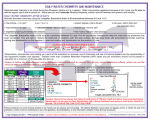- Jan 7, 2019
- 15
- Pool Size
- 12000
- Surface
- Plaster
- Chlorine
- Salt Water Generator
- SWG Type
- Jandy Truclear / Ei
New pool build/owner
Recently had PB do some punchlist items on a new pool build. I had the water GREAT for about 2 months.
there were some equipment issues and also some work that ended up putting a LOT of dust/debris back in the pool.
I've cleaned my filter a few times this week, and just did a brief soak in diluted acid per manufacturer ... the pressure is a lot better, but still not as low as it used to be. the filter itself looks pretty darn clean though....
I am still getting some air bubbles coming through the returns - trying to find why that's happening.
Today, my water tests showed:
TC- 4.5
FC- 4.5
CC- 0
PH- 8 (has been wanting a lot of acid since day 1, kinda normal for me to expect adjusting this)
TA- 50 (usually around 80)
CH-400 (usually around 325)
CYA- 20
Salt - 2,700 ppm
TDS - 4,000 ppm
Water Temp was 75
LSI ~ 0.6
I'm starting to see a bunch of what seems to be floating dust... there's construction nearby... so maybe it's actually dust or maybe calcium?
So my question is how to adjust these values?
Pool math says 14oz acid, 85oz (weight) baking soda, 42oz liquid stabilizer
I've never had to adjust TA as yet, so i'm hesitant to do it all at the same time.
any thoughts?
Recently had PB do some punchlist items on a new pool build. I had the water GREAT for about 2 months.
there were some equipment issues and also some work that ended up putting a LOT of dust/debris back in the pool.
I've cleaned my filter a few times this week, and just did a brief soak in diluted acid per manufacturer ... the pressure is a lot better, but still not as low as it used to be. the filter itself looks pretty darn clean though....
I am still getting some air bubbles coming through the returns - trying to find why that's happening.
Today, my water tests showed:
TC- 4.5
FC- 4.5
CC- 0
PH- 8 (has been wanting a lot of acid since day 1, kinda normal for me to expect adjusting this)
TA- 50 (usually around 80)
CH-400 (usually around 325)
CYA- 20
Salt - 2,700 ppm
TDS - 4,000 ppm
Water Temp was 75
LSI ~ 0.6
I'm starting to see a bunch of what seems to be floating dust... there's construction nearby... so maybe it's actually dust or maybe calcium?
So my question is how to adjust these values?
Pool math says 14oz acid, 85oz (weight) baking soda, 42oz liquid stabilizer
I've never had to adjust TA as yet, so i'm hesitant to do it all at the same time.
any thoughts?


